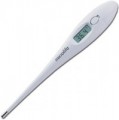Measurement duration
The time it takes for a thermometer to provide a temperature reading, from contact or activating the IR sensor to obtaining the result, is crucial for efficiency. Quick measurements save time during temperature checks. However, it's important to mention that for axillary use (see "Application area"), it's advised to keep the thermometer in place for a minimum of 5 minutes, irrespective of the manufacturer's specified measurement time, due to the nature of the procedure.
Measurement range
The range of temperatures that a thermometer can measure.
For measuring body temperature, a range of 35 – 43 °C is considered ample, covering values encountered in individuals with high fever or hypothermia. Although modern medical thermometers may have broader ranges, especially those designed for water and air temperature measurement (e.g., -20 – 100 °C), when used for body temperature, they typically operate within a narrower range. The overall and "solid" measurement ranges are often specified separately in these thermometers.
Display backlight
Availability of
backlight at own display of the thermometer. This feature allows you to easily see the screen readings in low light and even in complete darkness.
Waterproof case
The presence in the design
waterproof case. This feature allows you to thoroughly wash the thermometer; this is especially important for multi-application models (see above) and when using the same device for multiple patients.
Flexible tip
The presence of a
flexible tip in the design. This feature is characteristic only for contact models (see "Type") — it is not required for an IR thermometer. A flexible tip can in some cases simplify the use of the thermometer (particularly for rectal measurements) and also reduce the risk of breakage (for example, a small child trying to break the device will only bend it instead).

